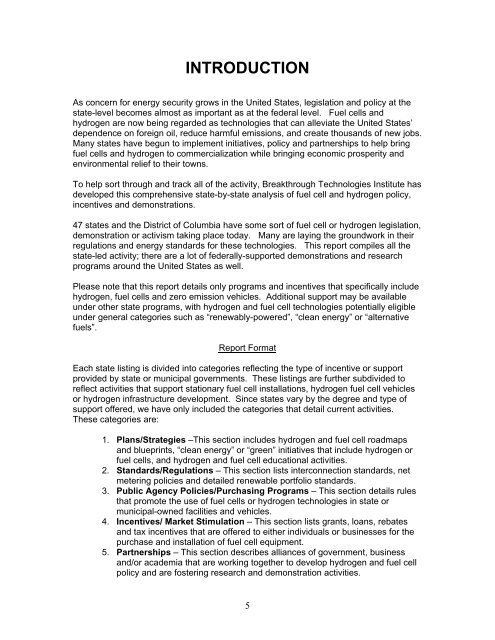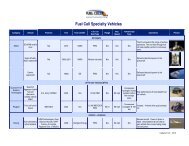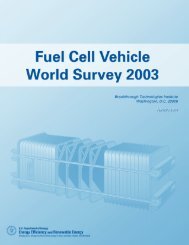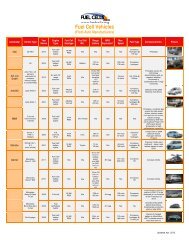Breakthrough Technologies Institute - Fuel Cells 2000
Breakthrough Technologies Institute - Fuel Cells 2000
Breakthrough Technologies Institute - Fuel Cells 2000
Create successful ePaper yourself
Turn your PDF publications into a flip-book with our unique Google optimized e-Paper software.
INTRODUCTION<br />
As concern for energy security grows in the United States, legislation and policy at the<br />
state-level becomes almost as important as at the federal level. <strong>Fuel</strong> cells and<br />
hydrogen are now being regarded as technologies that can alleviate the United States’<br />
dependence on foreign oil, reduce harmful emissions, and create thousands of new jobs.<br />
Many states have begun to implement initiatives, policy and partnerships to help bring<br />
fuel cells and hydrogen to commercialization while bringing economic prosperity and<br />
environmental relief to their towns.<br />
To help sort through and track all of the activity, <strong>Breakthrough</strong> <strong>Technologies</strong> <strong>Institute</strong> has<br />
developed this comprehensive state-by-state analysis of fuel cell and hydrogen policy,<br />
incentives and demonstrations.<br />
47 states and the District of Columbia have some sort of fuel cell or hydrogen legislation,<br />
demonstration or activism taking place today. Many are laying the groundwork in their<br />
regulations and energy standards for these technologies. This report compiles all the<br />
state-led activity; there are a lot of federally-supported demonstrations and research<br />
programs around the United States as well.<br />
Please note that this report details only programs and incentives that specifically include<br />
hydrogen, fuel cells and zero emission vehicles. Additional support may be available<br />
under other state programs, with hydrogen and fuel cell technologies potentially eligible<br />
under general categories such as “renewably-powered”, “clean energy” or “alternative<br />
fuels”.<br />
Report Format<br />
Each state listing is divided into categories reflecting the type of incentive or support<br />
provided by state or municipal governments. These listings are further subdivided to<br />
reflect activities that support stationary fuel cell installations, hydrogen fuel cell vehicles<br />
or hydrogen infrastructure development. Since states vary by the degree and type of<br />
support offered, we have only included the categories that detail current activities.<br />
These categories are:<br />
1. Plans/Strategies –This section includes hydrogen and fuel cell roadmaps<br />
and blueprints, “clean energy” or “green” initiatives that include hydrogen or<br />
fuel cells, and hydrogen and fuel cell educational activities.<br />
2. Standards/Regulations – This section lists interconnection standards, net<br />
metering policies and detailed renewable portfolio standards.<br />
3. Public Agency Policies/Purchasing Programs – This section details rules<br />
that promote the use of fuel cells or hydrogen technologies in state or<br />
municipal-owned facilities and vehicles.<br />
4. Incentives/ Market Stimulation – This section lists grants, loans, rebates<br />
and tax incentives that are offered to either individuals or businesses for the<br />
purchase and installation of fuel cell equipment.<br />
5. Partnerships – This section describes alliances of government, business<br />
and/or academia that are working together to develop hydrogen and fuel cell<br />
policy and are fostering research and demonstration activities.<br />
5






